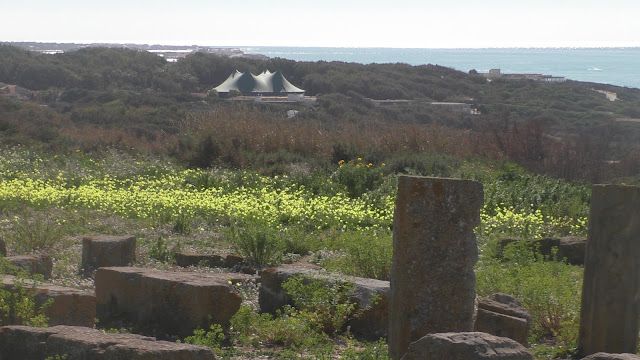Saturday 6th February, 2016
The weather since we arrived has been sunny, but breezy and chilly. Yesterday, though the thermometer read 18 degrees, the wind chill made it feel much colder. It was a day for doing things rather than sitting in the sun. The forecast for today was for the wind to drop, so we searched around for somewhere which looked interesting to cycle to. Our Michelin road atlas pinpointed a historical monument at Camerina, about 10 kilometres to the west along a minor road. Our somewhat outdated guidebook informed us that the Ancient Greek city of Kamerina had been destroyed by the Romans in 288BC and though there were only foundations remaining, there was a small museum. Google maps on the other hand pinpointed the place as the location of a large Club Med resort. This mixture of the sublime and ridiculous seemed to good to miss, so we headed-off mid-morning to have a bit of an explore.
The weather since we arrived has been sunny, but breezy and chilly. Yesterday, though the thermometer read 18 degrees, the wind chill made it feel much colder. It was a day for doing things rather than sitting in the sun. The forecast for today was for the wind to drop, so we searched around for somewhere which looked interesting to cycle to. Our Michelin road atlas pinpointed a historical monument at Camerina, about 10 kilometres to the west along a minor road. Our somewhat outdated guidebook informed us that the Ancient Greek city of Kamerina had been destroyed by the Romans in 288BC and though there were only foundations remaining, there was a small museum. Google maps on the other hand pinpointed the place as the location of a large Club Med resort. This mixture of the sublime and ridiculous seemed to good to miss, so we headed-off mid-morning to have a bit of an explore.
We had only pedalled a few kilometres when we came across a car park and what appeared to be a country park. We locked our bikes at the entrance and headed off for a wander. In fact the forest preserve of Randello is a lovely patch of pine forest leading to dunes and a secluded beach. It is a rare natural enclave in an area where large scale agro-industry is dominant.
 |
Indeed for most of our journey we were surrounded by the lacrustine glint of plasticulture. The warm micro-climate of south-east Sicily had made it into a world famous centre for the cultivation of cherry tomatoes. Like in Murcia in Spain, there must be hundreds of square kilometres under plastic, growing not only the famous Pacino tomatoes, but aubergines, courgettes and culinary herbs by the ton.
Little did Elizabeth David back in the 1950s realise that her pioneering books on Mediterranean cookery would provoke a revolution in the tastes of Northern Europeans. What was once grown by peasants is now produced by the ton so every Waitrose can stock fresh Italian tomatoes. Economically it has allowed Sicily to flourish, but like all industrial revolutions the resultant impact of the landscape is never picturesque, and we are left with the dilemma of trying to compute an acceptable price for progress.
Eventually the walls of plastic gave way to fields and we reached a turn-off signposted to the Museo do Scavi Camerina. The road wound it's way upwards through some low coastal hills. We passed the entrance to the Club Med resort, all closed-up for winter. At the brow of the hill there wasp a view westwards across fields of yellow flowers towards the nearby fishing village of Sciacca. Beyond the sea was a deep blue, and in the distance, the grey hills above Gela were barely visible.
 |
I had stopped to take a photo. Gill was waiting for me at the gates to the site. Although there are remains of a temple to Athena, this was difficult to spot. The ruins seem to consist mainly of stone coffins, and a grid of large rectangular blocks of mysterious purpose. No doubt had we paid up 4 euros each to visit the small museum, all would have become clear. However lunch was calling, so after admiring the view towards the beach and the Club Med pavilion, then wandering among the flowers and failing to identify any of them, we decided to head back to the van for lunch.
After two months of drizzle induced inactivity, the 16 mile round trip taken more out of me than I expected. By early afternoon I was stretched out by the van in a sheltered sunny spot, drifting inexorably towards the land of nod.
e










No comments:
Post a Comment